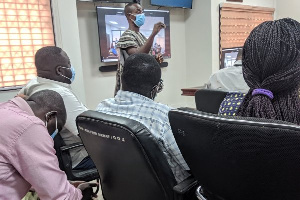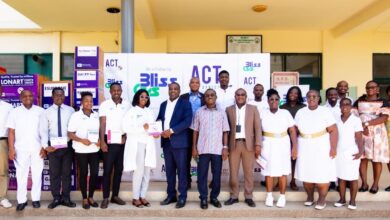Ashanti Regional Health Directorate reviews actions on preparedness, response for COVID-19

Regional health director makes submissions at a public event in Kumasi
The Ashanti Regional Health Directorate has conducted a qualitative review of actions taken so far in the region’s response to COVID-19 pandemic.
The action is to help identify best practices, lessons, and gaps in the response to facilitate consensus building and compiling lessons learned among the various response stakeholders to improve the current situation.
It would also sustain best practices that have demonstrated success and prevent recurrent errors as well as providing a basis to validate and update the region’s position in preparedness and response plan among other strategies.
The Region has the second largest number of COVID-19 cases in the country out of the 16 administrative regions.
It recorded its first confirmed case on the March 13th , 2020, and had since then recorded a total of 22,286 cases as at February 2022.
Kumasi Metro and its environs and Obuasi have been mostly affected by the pandemic, recording a total of 40 per cent of the cases in the region.
Dr Michael Rockson Adjei, Ashanti Regional Deputy Director, Public Health, speaking at the Intra-Action Review (IAR) meeting said some districts were used as response units to reflect the Region’s overall performance factoring high burden districts with regards to COVID-19 and those that were least troubled.
The districts were the Kumasi Metro, Oforikrom, Sekyere South, Obuasi-East, Obuasi Municipal, Ahafo-Ano South West and Sekyere Afram Plains.
The Ministry of Health, Ghana Health Service (GHS), World Health Organization (WHO) and other partners have planned to conduct a review of the response actions using WHO-IAR tool.
In Ghana it is being conducted in the Greater Accra, Ashanti and Northern Regions.
Dr Adjei noted that looking at the world with the events around, infections from animals (zoonotic diseases) were driving these outbreaks across the world, adding that, the country needed to position itself in a way and learn from current crises to be able to respond better to future events.
According to Dr Adjei, the overall outcome from the sampled areas was encouraging, explaining that the GHS was able to deploy innovation in contact tracing modalities, after the initial arrangement of having to pay people to go and do contact tracing.
It was integrated into routine service whereby the community health nurses also picked up contact tracing functions, thereby saving the cost of having to pay people for it.
They had innovation also in case management, the GHS at the onset of the pandemic did not have a high dependency unit for case management.
Dr Adjei said there was stronger collaboration with the Komfo Anokye Teaching Hospital who managed critical cases and when the patients improved, they shifted them to the lower facilities.
With respect to laboratory, none of GHS laboratories could test for COVID-19 within the region.
It was the Kumasi Center for Collaborative Research (KCCR), a quasi-institution, which came on board to fill in the gap in terms of confirming cases and soaked the pressure of test demand within the region.
Dr Adjei pointed out that there were, however, few areas that performed less well and believed these could be leveraged upon.
These were social mobilisation for vaccination, inadequate collaboration with some stakeholders including religious bodies and stakeholder collaboration in finding quarantine and isolation centers.




